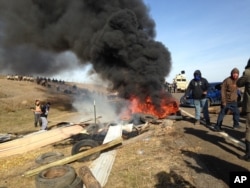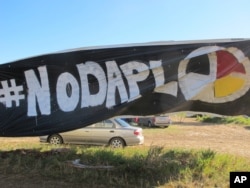Protests were relatively calm in the U.S. state of North Dakota Friday, following a day that turned violent between police and demonstrators opposing the construction of an oil pipeline across what police say is private property that has been occupied by Native Americans.
Thursday, over 100 police in full riot gear marched through a camp of protesters who then moved about a kilometer away and set up barricades near a river across from tribal land that is considered sacred.
As police moved in from the north, almost simultaneously, pipeline construction resumed to the west of the protest site near the city of Cannon Ball, North Dakota .
Authorities had dismantled the camp and arrested more than 100 people, including tribal elders who were praying peacefully. A new front line was established by protesters Friday.
Water bottles and one or two logs were thrown at police as they dismantled barricades and evicted protesters on a bridge, but most protests were non-violent.
The demonstrators are not a cohesive unit. Some insist on falling back and reject building barricades, while others push for more demonstrations or other actions. But no call for violence has been issued from either group of protesters. An officer said one of the protesters fired three shots Thursday, but it has not been verified.
As the protests died down late Thursday, a herd of buffalo came over a nearby hill, driven by men on horseback. Police are claiming it was an attempt to cause a stampede, and helicopters chased away the men.
Native Americans and their supporters, who include Green Party presidential candidate Jill Stein and veteran civil rights activist Jesse Jackson, say the pipeline will put the local water supply at risk and damage areas sacred to the local Standing Rock Sioux Indian tribe.
Protests had been intensifying since July when a permit was obtained to route the pipeline beneath the Missouri River at Lake Oahe, less than 1 kilometer from the Standing Rock Sioux Indian Reservation.
Hundreds of supporters came to Lake Oahe to support the local Sioux protesters. More than half of all Native American tribes in the U.S. have expressed support for the Standing Rock Sioux, and a number of members of Congress have written letters urging the Obama administration to stop the pipeline.
The federal government did ask the pipeline crews to stop construction work voluntarily near the Sioux reservation, while authorities reconsider the plans, but courts have refused to enforce the stop work order.










